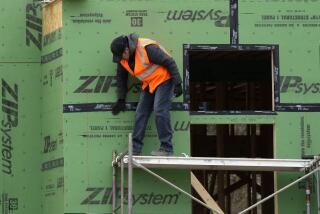State Posts Net Loss in Jobs
- Share via
As the housing boom comes to a close, the first ripples are beginning to be felt. California employment fell in March for the first time since last spring, a drop due almost entirely to a decline in construction workers, the state said Friday.
At its height, housing powered the economy. Newly flush homeowners spent enthusiastically on cars and toys and vacations. Builders sold homes as fast as they started them, spurring employment not only in construction but among lenders, brokers and agents.
That upward momentum is now beginning to reverse. Fewer homes are selling, mortgage rates are up and prices aren’t soaring the way they used to.
Builders stopped hiring last month. They needed 9,400 fewer workers in March, the second-biggest monthly drop in construction workers since 1995, the state Employment Development Department reported.
It’s possible that this tumble, which was largely responsible for last month’s overall net drop of 10,800 payroll jobs, is a bad omen for the state. But economists pointed out that it also has been raining a lot, which might be a mitigating factor. Construction slows in wet weather, and so does construction hiring.
Is construction in a tailspin or just suffering from a rain delay?
“That’s the $64,000 question,” said Howard Roth, chief economist for the state Finance Department. But he added that it was logical that the drop was prompted by more than weather.
“We’ve already seen a slowing in home sales, and we’ve already seen a slowing in [construction] permits,” Roth said. “The next step would be to see some slowdown in construction jobs.”
Even with the March drop, construction jobs grew 4.7% during the last year, more than twice as fast as employment as a whole. Only one employment category, natural resources and mining, grew faster, but its total number of workers is negligible.
“This shows the risks facing the California economy,” said Steve Cochrane, director of regional economics at forecasting firm Moody’s Economy.com. The risks, he said, were rising interest rates, record-low housing affordability and high energy prices.
Add these up, and you could be describing the ingredients of a slump.
Another negative note: Only four of 11 categories -- natural resources, information, financial and leisure/hospitality -- reported job gains in March. In recent months, gains have been nearly across the board.
In the future, they’ll have to be that way again to offset any losses in construction.
Luckily, Cochrane said, there also are a lot of counterbalancing positives: “The tech industry is doing well, international trade is accelerating and corporate profits are very good, which is generating demand for legal services, advertising, accounting.”
Alan Nevin, chief economist for the California Building Industry Assn., offered a third reason for the drop in construction employment: Major projects around the state have been delayed for a variety of reasons.
But he said that a more sustained drop was definitely in the cards.
“We projected this year we’d be off 10% in permits. If you’re down 10% in permits, you’re going to be down 10% in employment,” Nevin said.
He isn’t worried. Dropping 10,000 jobs, he said, doesn’t mean much when set against nonfarm employment of 15 million.
Sean Snaith, of the business forecasting center at the University of the Pacific in Stockton, was even more upbeat.
“An unusually rainy March may have dampened job growth in construction and the agricultural sectors, but our sunny forecast for the California economy remains unchanged,” he said in a statement.
Last month’s drop in employment was the biggest in the state since August 2004, when employment fell 15,500. The March drop came after a two-month spurt of 48,200 new jobs.
The unemployment rate fell to 4.8% from 5% in February. The rate, calculated by interviewing households, tends to vary from month to month.
Much of the Southland had lower jobless rates than the state as a whole. Orange County’s unemployment rate was 3.4%, while San Bernardino’s and Riverside’s both were 4.4%. Los Angeles County’s was 4.8%, mirroring the state.
Construction jobs fell in January 2005 by 12,600, but the biggest drop before that was in the trough of the last housing bust, January 1995, when a net 13,300 jobs disappeared.
Both declines were followed by rebounds. A few more months will be needed to establish a true downward trend this time around.
“What I really want to see is April’s numbers,” said Nevin of the builders’ association.
That probably won’t settle the debate. During much of this month, the rain continued.
More to Read
Inside the business of entertainment
The Wide Shot brings you news, analysis and insights on everything from streaming wars to production — and what it all means for the future.
You may occasionally receive promotional content from the Los Angeles Times.










